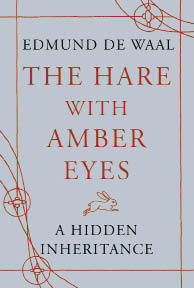Some years ago, Edmund de Waal inherited a remarkable collection of 264 netsuke from his great-uncle Iggie, whom he had got to know 20 years previously while studying pottery and Japanese in Tokyo. Each week the young de Waal visited his urbane, elderly relative and his friend, Jiro. He heard ancient family stories and was introduced to the hare and all the other miniature carvings in ivory or wood, each one ‘a small, tough explosion of exactitude’. When eventually he inherited the netsuke, he felt he had also been ‘handed a responsibility — to them and to the people who have owned them.’
Although the netsuke originated in 18th- century Japan, they came to Iggie from his childhood home in Vienna and, before that, from belle époque Paris via his father’s cousin, Charles Ephrussi. De Waal, however, is not interested in
a few stitched-together anecdotes … I want to know what the relationship has been between this wooden object that I am rolling between my fingers — hard and tricky and Japanese — and where it has been… I want to know whose hands it has been in, and what they felt about it and thought about it — if they thought about it. I want to know what it has witnessed.
Charles Ephrussi was the son of a Jewish grain merchant from Odessa, who moved to Paris when the family decided to set up a centre there for their operations. He lived in the rue de Monceau alongside Rothschilds and Camondos and bought the netsuke during the first flush of fashion for Japanese art after the country had been opened to the world by Commodore Perry. A friend to many contemporary artists, he was also studied by Proust as a model for Swann. He was too assimilated to pay much heed to French fin-de-siècle anti-Semitism, and was anyway somewhat insulated from it by his fabulous wealth.
De Waal imagines the fortunes of the netsuke through this aesthete’s ownership as their position shifts in his collection down the years, produced first from their custom-made vitrine as exotica and, later, making way for dozens of pictures by his friends among the Impressionists. He finally gave them as a wedding-present to his cousin Victor, who was at the centre of the family’s business activities (chiefly banking) in Vienna. As he did in Paris, De Waal finds the building the netsuke inhabited, a colossal palace on the Ringstrasse, and uses them to imagine how his great- grandparents lived. Where did these light, playful objects fit among the heavy, dark Empire furniture? For Victor had no enthusiasm for Secessionists or other Modernist claptrap: his sympathies stood with the Emperor, German culture and the classics. The vitrine of netsuke stood in his wife’s dressing-room, where the three children played with them when they visited their mother for an hour every Sunday morning.
When the Nazis arrived and the palace’s contents were stolen or smashed, the netsuke were overlooked. I shan’t give away the means by which they were saved and returned to the surviving members of the family, or how the family itself survived, but the way in which de Waal uses the netsuke is integral to the success of his intimate period portraits. The process of his own investigations redeems what is, inevitably, a tale of repeated loss, from nostalgia. For while the history of the netsuke matters very much to the author, it is in their present handling that they really come alive and affirm him as someone different from his wealthy forebears.
‘Objects have always been carried, sold, bartered, stolen, retrieved and lost … It is how you tell their stories that matters,’ de Waal writes. ‘How objects get handled, used and handed on is not just a mildly interesting question for me. It is my question.’ It is his question because of his supreme sensitivity to the tactile qualities of objects, which is apparent throughout this immensely captivating, moving — touching — family memoir; it is what drives it and makes it quite unlike any other book. Apart from any historical value that may lie in documenting the story of his family, he has made a valuable contribution to the scant literature that exists on the nature of touch.





Comments